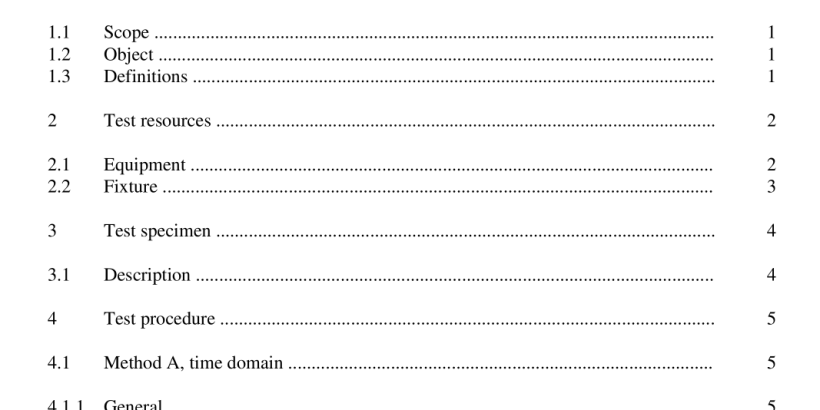ANSI EIA 364-90-2000 pdf download.Crosstalk Ratio Test Procedure for Electrical Connectors, Sockets, Cable Assemblies or Interconnect Systems
4.1.1.2.2 Fixture crosstalk contributes to the specimen crosstalk. The fixture includes minimum loss pads, if used. If the referencing document precisely describes the fixture so that its crosstalk contribution is known, then the fixture crosstalk measurement is optional. These results are a magnitude versus time plot. Measure the measurement system rise time, drive amplitude and fixture crosstalk with one of the following techniques.
4.1.2 Insertion technique
4.1.2.1 Assemble the fixture so that the near end is connected to the far end without the specimen in between, and connect the oscilloscope and pulse generator to the appropriate locations of the driven line fixture. For multiple simultaneously driven lines, match amplitudes and minimize the skew between lines, and if balanced, minimize skew within the pair. Measure and report the skew values.
4.1.2.2 If the number of lines to be driven simultaneously exceeds the equipment capability or channel skew elimination is a concern, the lines may be driven one at a time and the crosstalk calculated by superposition.
4.1.2.3 Measure the step rise time and amplitude of the drive signal transmitted through the fixture alone. (If requested this can be done using the fixture with specimen.) Adjust the filtering (or normalization) so the measured rise time matches the value requested, or a value from table 1.
4.1.2.4 Connect the oscilloscope to the quiet line location as specified in the referencing document. Measure the fixture crosstalk amplitude with the specimen removed. Calculate the fixture crosstalk ratio by dividing the fixture crosstalk amplitude by the step amplitude and express as a percent. Unless otherwise specified record the peak values and the sign.
4.1.3.4 Connect the oscilloscope to the quiet line location of the reference fixture specified in the referencing document. Measure the amplitude of the quiet line signal at its maximum excursion. Subtract from this value the amplitude of the quiet line signal prior to the time of the edge of the driven line signal to obtain the quiet line crosstalk value (maintaining the sign). Calculate the fixture crosstalk ratio by dividing the quiet line crosstalk value by the step amplitude and express as a percent.
4.2.2.2.4 Specimen crosstalk ratio Divide the fixture plus specimen crosstalk ratio by the fxture crosstalk ratio (subtract dBm) to obtain the specimen crosstalk ratio in dB. When requested, the reference signal may be measured at the far end of the specimen by including the specimen in this measurement.
4.2.3 Reference fixture technique
Construct a reference fixture that is missing provision for a specimen, but is otherwise identical. This reference fixture combines both the near end and far end. Connect the network analyzer ports, or the signal generator and spectrum analyzer to the appropriate locations of the driven line fixture. Perform a “through” calibration with the network analyzer, or make a reference measurement with the signal generator and spectrum analyzer. (If requested, do this using the fixture with specimen). Connect the receiver port of the network analyzer or the spectrum analyzer to the quiet line location of the reference fixture requested in the referencing document. Measure the fixture crosstalk ratio in dB (network analyzer) or fixture crosstalk in dBm (spectrum analyzer) without the specimen. To get fixture crosstalk ratio with a spectrum analyzer, divide this by the reference measurement.ANSI EIA 364-90-2000 pdf download
